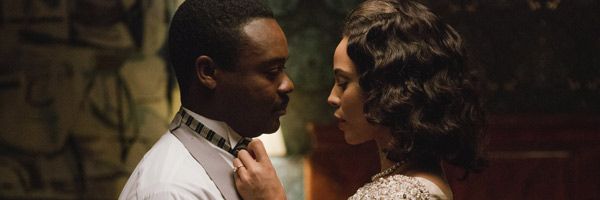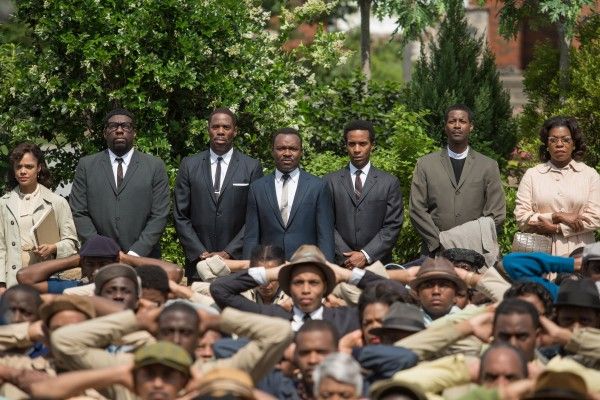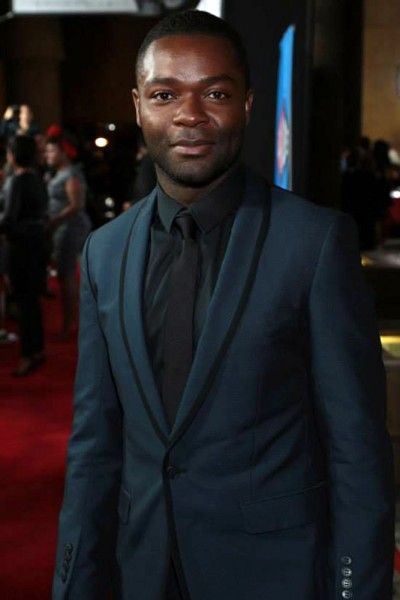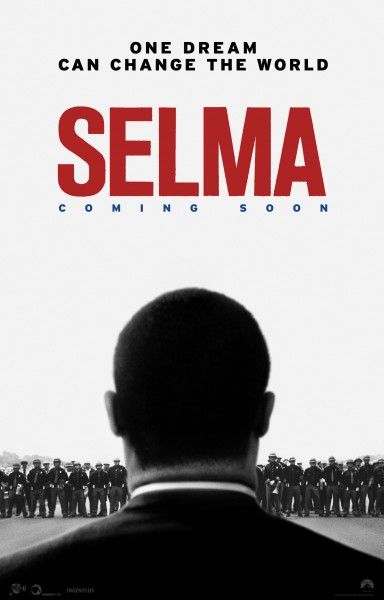Selma is a beautifully designed film that not only hits you emotionally in the gut, but also makes you feel for the humanity that the Civil Rights movement was fighting for. While Martin Luther King Jr. was just a man, he spoke for and to people willing to defy intimidation, face economic retaliation, and endure arrests and beatings, all in hopes of provoking a transformative confrontation that would give African Americans the basic rights that they so desperately wanted and deserved. Expertly directed by Ava DuVernay, the film stars David Oyelowo (in an award-worthy performance as Dr. King), Carmen Ejogo, Tom Wilkinson, Tim Roth, Oprah Winfrey, Andre Holland, Common, Giovanni Ribisi, Tessa Thompson, Dylan Baker, Alessandro Nivola and Omar Dorsey.
During a roundtable interview at the film’s press day, actor David Oyelowo and director Ava DuVernay talked about taking on someone so very well known, never hesitating in showing the violence and aggression that took place, the challenges of making Martin Luther King Jr. human, casting actors who best fit around David Oyelowo, making the dream to play Dr. King a reality, the most memorable scene they experienced together, what the prep work was like, having some of the real people around, and the flavor that being in the real locations added to the film. Check out what they had to say after the jump.
Question: Ava, what was it like to take on someone who is so very well known?
AVA DuVERNAY: Selma takes place between “I Have A Dream” and his death, so he was at full-throttle popularity. His life was too big and too epic to put into two hours. I just don’t know how you do a cradle-to-the-grave for King in two hours. Some other people, you could, but his life was so episodic. There was just so much to the political through-line of his life. I had to pick something, and Selma was right in pocket. It’s all in that three months, and you can get it all in there. Staying true to that commitment, you could synopsis the world of his life in that three months.
Many of the moments are really painful to watch, but they need to be there. Were you always thinking about the balance of the film, and the emotions you needed to evoke?
DuVERNAY: I never hesitated in showing the violence and aggression. You cannot fully understand the risk, the commitment and the faith, unless you show what the test was, and the test was walking up to a line of state troopers who are out to get you, and not there to protect you. Unless you know what that feels like and you know what they are capable of doing, then the test feels soft. That’s been a challenge for some Civil Rights films in the past. It’s soft. My dad is from Montgomery, Alabama. I’ve heard all of those stories. I heard the stories, as a 9-year-old, of him going to the store and his uncle having to step off the sidewalk, or being pushed and harassed. That test has to be shown, so I never veered away from showing it. I think you do a disservice to the real people, if you make that vanilla and sugar-coat it. We just tried to go for it.
How challenging was it to make Martin Luther King Jr. human?
DuVERNAY: We always talked about that. We know him as a statue. We know him as a holiday. We know him as a speech. We don’t know him as a man. Most people don’t even know the whole speech, just “I have a dream.” They don’t know what his speaking voice was like, how he looked at his wife, or that he had four kids. Those little pieces became so important. We worked really close together to find those moments. Our collaboration was so close. You can find those moments when you’re working with an actor who’s already so deep in the pocket of the character. When we stepped onto the set, I didn’t talk to David [Oyelowo] about getting into character. That was already there, so it allowed us to go deeper. There was room and time to do it.
With such a tremendous cast in this film, what was the casting process like?
DuVERNAY: The biggest piece of casting was already in place when I walked in the door, and that was [David Oyelowo]. Who wants to do the national search for Dr. King? Not me. That was done. We had this crown jewel, and everything we put around it, in my mind, was just an adornment to that. It was just about adding to the facets of David. When we were casting Coretta or casting Abernathy, it was always about who fits with David. That made it much easier for me.
David, did you really feel like you heard from God in 2007 that you were supposed to play Dr. King, and how did you make that a reality?
DAVID OYELOWO: That’s absolutely true. My wife and I had moved to L.A. from the U.K., in May of 2007, and in July of 2007 is when I first read the script. We were living here with two kids, at the time. We now have four. You have this moment of, “What on earth are we doing here?!,” but we felt called to move. So, I was in a time of deep prayer and was going, “Lord, I just pray this works.” And then, this script came along. I guess because I was very much in a space of, “Talk to me, Lord,” because we made this big move, I read that script and, very clearly, God said to me, “You are going to play Dr. King in Selma.” It wasn’t just, “You are going to play Dr. King.” It was this film. And that was so weird to me that I started a prayer diary that day, and that’s the first entry in it. That’s why I know the date so clearly. It was like, “I’m British. I’ve not done barely any American movies. Who on earth do I think I am?” It was so crazy, but it lodged in my spirit in a way that I couldn’t shake it. My wife helped me put a couple of scenes on tape, and we sent it to the director (Stephen Frears), at the time. Unfortunately, he didn’t agree with God, so that didn’t work out.
And then, God fired him.
OYELOWO: I love that! I may tell him that when I see him, and see how that goes. So many things happened in the interim, but to literally go from a situation whereby the director attached, at the time, didn’t want me to me being able to suggest a director I love, adore and knew was right, is just an extraordinary, undeniably miraculous situation. Also, considering that the film we had done together was a tiny $200,000 movie, that was a beautiful movie that won Ava Best Director at Sundance in 2012, to then go to this size of movie, which is a spike for anyone, and for us to get it done was a miracle. The miracles around this film have been undeniable, from day one.
What was the most memorable scene that you guys experienced together?
DuVERNAY: We had this thing called Speech Day, as we were designing the schedule for the shoot. We knew we had 32 days and had to map out what would go on any particular day. So, we decided to do both of the speeches in the church – Jimmie Lee Jackson’s funeral speech and “Give Us The Vote” – on the same day, back to back. We would load in the church and change the extras. And then, we decided to move Speech Day to the second week, so that David could get warmed up. Speech Day was a big day. When you’re playing Dr. Martin Luther King Jr., it’s not easy to step into that great orator’s shoes. And we got there and loaded in the extras. It was a little bit of a rainy day in Atlanta. Everyone was in there and cozy. We had 500 people in period clothes. The cameras were set up and everything was ready to go, and there was only a little rain outside. David prayed with the extras who felt like a real congregation. We had three cameras going and said, “Rolling!” I just had sat down with the little monitor that I use in my hand. I was in the pew and I was about to call, “Action!”
OYELOWO: And then, all the lights went out. Every single light went out.
DuVERNAY: The electricity went out, in the whole place. It was an electrical storm.
OYELOWO: It was un-forecast, by the way.
DuVERNAY: It wasn’t on anything we’d seen. I don’t think we would have checked for it, anyway, because we were inside.
OYELOWO: So, the lights went out and literally everyone went, “Ooh!” We had gotten to such a peak. I had prayed with everyone. The real John Lewis was in the front row.
DuVERNAY: I think the extras might have thought it was a part of the scene.
OYELOWO: The timing was crazy! I was calling my pastor saying, “The devil is up to something. The lights just went out. Y’all need to pray!” He was so wonderful. He said, “David, God speaks in the thunder and the lightening. It’s fine.” And I was like, “I don’t know.” But the amazing thing was that we had prayed together as this huge congregation, we broke for dinner, and it was this electrical storm combined with a sunset.
DuVERNAY: It made front-page international news. Websites were picking up these pictures. I’d never seen anything like the sky. It was purple, and then it turned orange, and then it turned pink. And there were two rainbows. It was a huge thing. At that moment that it happened, we went outside and took a picture. In a moment when it was a disaster because we had one day to get two speeches and we had lost time and were running against time to get it done, a peace came over us and it was confirmed when we went outside. We knew it was meant to be that way. And then, when we loaded everyone back into the church, they had now been through something together. They were really a congregation, at that point.
OYELOWO: Not only that, the conversations were like, “Did you see that sky?!” People were like, “You better preach, motherfucker! There’s a double rainbow!”
DuVERNAY: So, when we got into the scene and he did it, he had less time to do the speeches, but he was so in pocket, so in tune with what he was doing, and so present. He always is, but there was an extra lift. All of that clapping is real. There’s not any additional sound. They were just listening to him and feelin’ it. That was the best day.
OYELOWO: It was undeniable and tangible. Whether you’re a person of faith or not, we went through something. Technically, as an actor, you learn the lines and you have a notion of how you’re gonna do it. I was surfing. It didn’t feel like acting. There was an energy that one could just glide upon.
DuVERNAY: We did maybe only two takes of those speeches. He was just killin’ it.
David, what was your prep work like, in capturing Martin Luther King Jr.?
OYELOWO: Well, the first thing I made sure I did was not go around Atlanta talking [in my own accent]. You don’t want people thinking, “What?!” We did a dinner for those iconic pastors and I had the accent because I didn’t want to break it. Joseph Lowery said, “So, I hear that you’re from England. As far as I can remember, Dr. King was not from England.” I was like, “Oh, no! This is so bad.” He said, “I saw you in The Butler. I thought you were aight.” But meeting them, to be perfectly honest, is part of why this is an important film to do. They are heroes in the very true sense. To me, sacrificial love is the greatest attribute that we exhibit, as human beings. That attribute is so beautifully demonstrated by Jesus Christ, and that is what these people did. Their faith married up with their social activism, and we live in a different America because of them. They have been so under-celebrated, so for us, that was an incredible day where they all came and, in a way, anointed our film.
What did it mean to you and the making of this film, to have those real people around?
DuVERNAY: Andrew Young was really pivotal in my process, as a director, ‘cause I was speaking with him before we shot. I was just like, “Hey, ambassador, did this happen? How was this?” I was able to bounce things off of him, quite a bit. He came to the set a couple of times. When Congressman Lewis walked in, it was amazing. The real CT Vivian came. I had some conversations on the phone with Diane Nash. These legends, these icons, these really beautiful people are moving on to the next plane, and it was time for this story to be told.
How did the real locations flavor this movie, especially being on that bridge?
OYELOWO: It was such a blessing to be in the exact place. As an actor, you’re always trying to shelve acting and get to the place of being. On that bridge, with people who were part of the march, it was very much a living memory. People in their 60s, 70s and 80s were there. We shot it in Selma, on that bridge with people that were local to Selma. They knew the stories. It’s part of their heritage. To be on that bridge with people coming up to you with stories that they remember, you’re just like, “Oh, my goodness.” And the re-enaction was so exact. It was the same thing for the speech on the Montgomery steps, in the exact same spot. Our genius production designer had a lectern up there for me to give the very last speech in the film, but it just wasn’t right. So, he walked across the street to DexterAvenueBaptistChurch and asked if he could use the pulpit. They said, “No, it’s fixed to the front of the church. But, we did find a pulpit in the basement, two days ago. You can use that one.” He puts it up there and goes to archival footage, and it’s the exact same pulpit. Two days before he asked, they found it, and it’s the exact same one. You can see the scratches and markings on it. So, he called me, the day that I was about to give the speech and was like, “Oh, my goodness, it’s the exact same pulpit!” I was like, “Don’t tell me! I have to actually give the speech. I can’t be dealing with the fact that God just showed up again.” It wasn’t until after that I was just like, “Oh, my goodness, the pulpit!” I just couldn’t. It’s the exact same one. When that’s going on, you just have to go, “Okay, something else is in charge here. Just stay in pocket and get the thing done.”
Selma opens in select theaters on December 25th, and nationwide on January 9, 2015.




